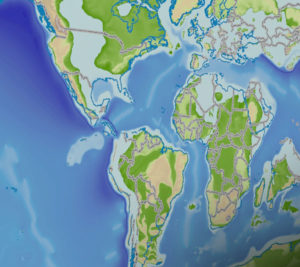Creating tectonic reconstructions requires diverse data from across geology and geophysics; methods and techniques to uncover the tectonic evolution of one area often don’t apply to another.
In this series of three blog posts, we look at interesting tectonic problems from around the globe, the data required to solve them and why better understanding of the tectonic systems leads to better insights into the formation and preservation of petroleum systems and ultimately better exploration decisions.
Here, in Part 1 we look at the provenance of detrital zircons in sandstones in Myanmar and how they help to solve the tectonic puzzle.
Part 1 – Provenance Analysis in Myanmar
Myanmar has numerous prospective hydrocarbon basins with proven hydrocarbon potential onshore and along its margin with the Indian Ocean. These basins are surrounded by complex tectonic collages and a highly transpressional margin with the Indian Ocean. Onshore ‘exotic’ continental blocks, such as the West Burma Block (Figure 1), are trapped in the compression zones, uplifted and eroded, making it challenging to uncover their pre-collision history.

Here we use zircon U-Pb geochronology to illuminate the tectonic history of the West Burma Block and to reduce uncertainty in basin models of prospective basins in Myanmar.
Two major hypotheses from the origins of the West Burma Block have been published (Figure 2):
1. The West Burma Block where the Block is rifted from western Australia in the Jurassic and accreted to South East Asia in the Cretaceous (e.g. Longley et al., 2002; Heine et al., 2004).
2. The West Burma Block was part of the SE Asia core by the Early Mesozoic (e.g. Gatinsky and Hutchison, 1986; Hutchison, 1989; Mitchell, 1992; Barber and Crow, 2005, 2009; Hall et al., 2009; Metcalfe, 2011; Hall, 2012; Morley, 2012; Hall, 2014). This implies that it was part of Gondwanan Sibumasu or the Cathaysian West Sumatra Block (Barber and Crow, 2005).

Triassic turbiditic sandstones in the Chin Hills were deposited on the West Burma Block and are composed of detrital fragments derived from areas neighbouring this block at the time of deposition.
Provenance analysis of detrital zircons in these Chin Hills sandstones reveals an abundance of zircons of Permian and Triassic age. Similar zircon populations are not observed in rocks of the Western Australian margin (Figure 3); the Proterozoic zircon populations are similar between western Australia and the West Burma Block.

Paleozoic zircons were interpreted to be sourced from the Australian cratons, suggesting initial proximity between Western Australia, West Burma and Sibumasu (Eastern Myanmar, parts of Thailand and Malaysia).
The Paleozoic and older zircon populations of Indochina (the continental core of Southeast Asia) vary somewhat from those in western Australia and West Burma suggesting these blocks have not been neighbours in the recent geological past.
In contrast, West Burma and Indochina show similar populations of zircons in the Permian and Triassic which are not prevalent in Western Australia. Permian-Triassic zircons are common in Southeast Asia and are sourced from granitoids in the Southeast Asian tin belt.
Permian–Triassic zircons are also present on the NW Shelf (e.g. in the Carnavon Basin, Lewis and Sircombe, 2013) but they are not as abundant as those in Southeast Asia; their peak ages also differ from those observed in the West Burma and Indochina Blocks. (Sevastjanova et al., 2016)
To assist with basin model predictions, we have also considered whether the western margin of Myanmar was active through the Cenozoic. If active subduction occurred at the margin during the Cenozoic, we can imply that hydrocarbon basins in the forearc experienced extension due to slab rollback.
Geochronology of in situ zircons from igneous rocks in the Wuntho-Popa Arc and detrital zircons in the onshore sedimentary basins (Figure 4) along with cathodoluminescence images, hafnium isotope data and sandstone petrography (presence of volcanic clasts) distinguishes zircons of juvenile igneous rocks from those reworked from older crust.
These data suggest that subduction-related magmatism occurred in Myanmar in Cretaceous and Cenozoic, and so provides evidence for ongoing, although non-continuous subduction on its western margin. These data provide useful evidence that petroleum-bearing basins at the Myanmar margins have undergone subduction rollback related extension since Cretaceous; this information can be used in basin models to better understand potential sources of hydrocarbons.

Written by Peter Webb and Inga Sevastjanova










